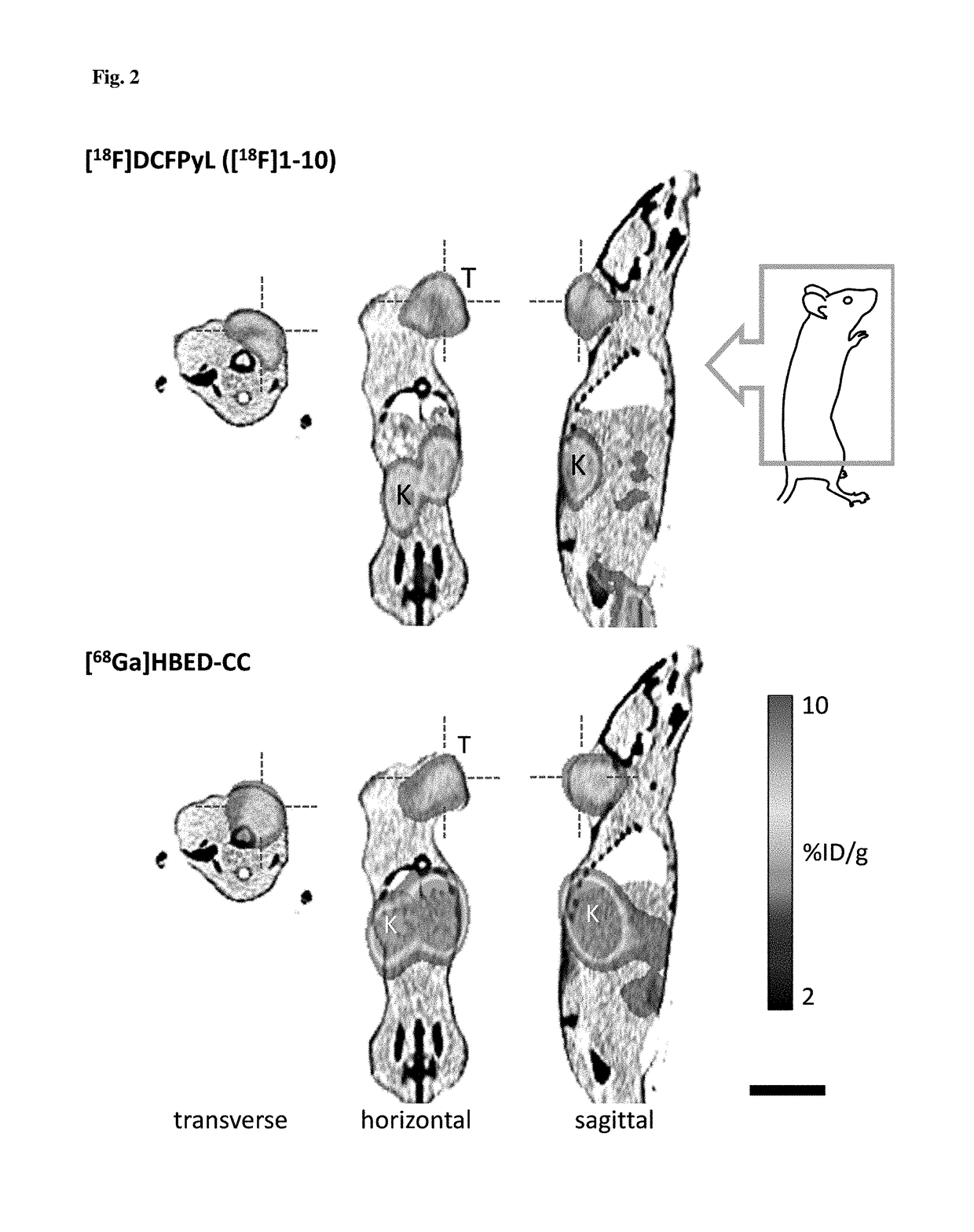Method for the production of 18F-labeled active esters and their application exemplified by the preparation of a PSMA-specific PET-tracer
a technology of active esters and psma, which is applied in the field of production of 18flabeled active esters, can solve the problems of limited stable activity of active esters under basic conditions, mainly n-succinimidyl 4-[sup>18, sup>f]fluorobenzoa
- Summary
- Abstract
- Description
- Claims
- Application Information
AI Technical Summary
Benefits of technology
Problems solved by technology
Method used
Image
Examples
examples
Abbreviations:
[0286]βAla (beta-alanine), Boc (tert-butyloxycarbonyl), DCC (N,N′-dicyclohexylcarbodiimide), DMF (dimethylformamide), DMM (dimethoxymethane), DMSO (dimethyl sulfoxide), EDC (1-ethyl-3-(3-dimethylaminopropyl)carbodiimide), EDTA (ethylenediaminetetraacetic acid), Glu (glutanic acid), Gly (glycine), Lys or syL (lysine) mCPBA (meta-chloroperoxy benzoic acid), MeCN (acetonitrile), ONSu (N-oxy-succinimide), OTf (trifluoromethanesulfonate), Tos (tosyl), PMB (p-methoxybenzyl), Py (pyridinyl), tBu (tert-butyl), TFA (trifluoroacetic acid), TFE (tetrafluoroethyl alcohol), TFP (2,3,5,6-tetrafluorophenyl), THF (tetrahydrofuran), TIS (triisopropylsilane), TMS (trimethylsilyl).
Example 01: Preparation of 2,3,5,6-Tetrafluorophenyl-6-[18F]fluoronicotinate ([18F]F-Py-Tfp, 3c)
[0287]
Procedure A:
[0288]Aqueous [18F]fluoride (0.05-50 GBq) was trapped on a anion-exchange resin (QMA or Chromafix® 30-PS—HCO3 cartridge). It should be noted, that in the case of QMA cartridges, the aqueous [18F]flu...
example 04
n of 2,3,5,6-Tetrafluorophenyl 4-Iodobenzoate 20
[0294]
[0295]Et3N (1.504 mL, 0.76 g, 7.51 mmol) was added dropwise to a vigorously stirred solution of 4-iodobenzoyl chloride 19 (2 g, 7.51 mmol) and 2,3,5,6-tetrafluorophenol (1.25 g, 7.51 mmol) in Et2O (60 mL) and the stirring was continued for a further 10 min. The reaction mixture was filtered, the filter cake was washed with Et2O (30 mL) and the filtrate was concentrated under reduced pressure. The residue was dissolved Et2O (10 mL) and filtered. The filtrate was concentrated under reduced pressure. The residue was recrystallized from Et2O / hexane to give the title compound (1.38 g, 48%) as a colorless solid.
[0296]Rf=0.46, EtOAc:hexane=1:10.
[0297]1H-NMR (CDCl3, 300 MHz): δ=7.07 (tt, J=9.9, 7.1 Hz, 1H), 7.82-7.98 (m, 4H);
[0298]19F-NMR (CDCl3, 282.4 MHz): δ=−152.70, −138.80;
[0299]13C-NMR (CDCl3, 75.5 MHz): δ=103.0, 103.4 (t, J=23.0 Hz), 126.6, 131.9, 138.3, 138.9-142.7 (m), 144.4 (dt, J=3.8, 12.1 Hz), 147.7 (dt, J=4.5, 12.1 Hz), 162.2...
example 05
n of (4-Methoxyphenyl) [4-(2,3,5,6-tetrafluorophenoxycarbonyl)phenyl]iodonium tosylate 21
[0300]Tos.H2O (0.72 g, 3.79 mmol) was added to a solution of 2,3,5,6-tetraphenyl 4-iodobenzoate 20 (1 g, 2.52 mmol), mCPBA [1.44 g, 85% purity, 7.09 mmol; commercially available 77% mCPBA (Aldrich) was dried at 2 mbar and 40° C. for 3 h before use] and anisole (0.51 mL, 0.51 g, 4.72 mmol) in 50% CF3CH2OH (TFE) in CH2Cl2 (20 mL) and the mixture was stirred for 3 days. The reaction mixture was added to vigorously stirred Et2O (450 mL) and stirring was continued for a further 45 min. The precipitate was filtered off and washed with Et2O (100 mL), redissolved in CH2Cl2 (20 mL) and filtered through Celite®. The filtrate was concentrated under reduced pressure. The residue was recrystallized from CH2Cl2 / Et2O to give the title compound (1.53 g, 90%) as a colorless solid.
[0301]1H-NMR (CDCl3, 300 MHz): δ=2.28 (s, 3H), 3.77 (s, 3H), 6.80 (d, J=9.0 Hz, 2H), 6.97 (d, J=6.0 Hz, 2H), 7.01-7.14 (m, 1H), 7.36 (...
PUM
| Property | Measurement | Unit |
|---|---|---|
| reaction temperature | aaaaa | aaaaa |
| temperature | aaaaa | aaaaa |
| temperature | aaaaa | aaaaa |
Abstract
Description
Claims
Application Information
 Login to View More
Login to View More - R&D
- Intellectual Property
- Life Sciences
- Materials
- Tech Scout
- Unparalleled Data Quality
- Higher Quality Content
- 60% Fewer Hallucinations
Browse by: Latest US Patents, China's latest patents, Technical Efficacy Thesaurus, Application Domain, Technology Topic, Popular Technical Reports.
© 2025 PatSnap. All rights reserved.Legal|Privacy policy|Modern Slavery Act Transparency Statement|Sitemap|About US| Contact US: help@patsnap.com



